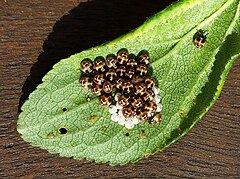Stagonomus venustissimus
| Stagonomus venustissimus | |
|---|---|

| |
| Adult of Eysarcoris venustissimus | |
| Scientific classification | |
| Kingdom: | |
| Phylum: | |
| Class: | |
| Order: | |
| Suborder: | |
| Infraorder: | |
| Superfamily: | |
| Family: | |
| Subfamily: | |
| Genus: | |
| Species: | E. venustissimus
|
| Binomial name | |
| Eysarcoris venustissimus (Schrank, 1776)
| |
| Synonyms | |
| |
Eysarcoris venustissimus, common name woundwort shieldbug, is a species of shieldbug belonging to the family Pentatomidae, subfamily Pentatominae.
Scientific name
The species was first named by Fabricius as Cimex melanocephalus.[1] However this name had already been used by Linnaeus for the mirid bug now known as Phylus melanocephalus - at the time, the genus Cimex encompassed the entirety of the Heteroptera. The replacement name Eysarcoris fabricii given by Kirkaldy in 1904 was used for many years, but Rider (1998)[2] pointed out the name venustissimus given by Schrank to what he called Schönste Wanze - most beautiful bug,[3] and this is now the accepted name.
Distribution
This species can be found in most of Europe.[4][5]
Description
Eysarcoris venustissimus can reach a length of 5–7 millimetres (0.20–0.28 in). These small bugs have a greenish-grey body. The head and the pronotum are copper coloured. They have a bronze-purple triangular stain at the base of the scutellum. The connexivum has black and white markings. The legs are whitish with black spots[6]
Biology
Eysarcoris venustissimus is an univoltine species. The larvae are visible from late June to October, while the new generation of adults appear from August through the following July.[7]
The nymphs feed on hedge woundwort (Stachys sylvatica), particularly the seeds, and on Lamiaceae species, especially on white dead-nettle (Lamium album).[6]
Gallery
-
Mating
-
Eggs and young nymphs
-
Adult with final instar nymph
-
Imago
References
- ^ Io. Christ. Fabricius (1775). Systema entomologiae: sistens insectorum classes, ordines, genera, species, adiectis synonymis, locis, descriptionibus, observationibus. Flensburg et Lipsiae (Leipzig). pp. 716-717.
- ^ D. A. Rider (1998). "Nomenclatural changes in the Pentatomoidea (Hemiptera-Heteroptera: Cydnidae, Pentatomidae). II. Species level changes" (PDF). Proceedings of the Washington Entomological Society. 100 (3). p. 453.
- ^ Franciscus de Paula Schrank (1781). Enumeratio insectorum Austriae indigenorum. Augusta Vindelicorum (Augsburg). p. 277.
- ^ Fauna europaea
- ^ D. A. Rider (2006). "Pentatomidae". In Aukema B, Rieger C (eds.). Catalogue of the Heteroptera of the Palaearctic Region, vol. 5: Pentatomomorpha II. Amsterdam: Netherlands Entomological Society. ISBN 9789071912283.
- ^ a b British Bugs
- ^ Nature Network Amiens
External links




